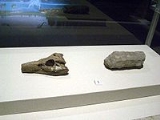
Hsisosuchus
Encyclopedia
Hsisosuchus is an extinct genus
of crocodyliform
from China
. Currently there are three species within this genus. H. chungkingensis and H. chowi are from the Late Jurassic
. H. dashanpuensis is from the Middle Jurassic
.
Fossils of H. chungkingensis were found in the Shangshaximiao Formation (near Chongqing
city). The holotype
consists of the cranial skeleton and caudal osteoderm
s. A more complete specimen was found and described that added significant information on the postcranium
of H. chungkingensis.
H. dashanpuensis was found in the Xiashaximiao Formation.
H. chowi was found in the Shangshaximiao Formation. The holotype specimen consists of a nearly complete skull (25 cm long), mandibles, most of the vertebral column, partial pectoral and pelvic girdles
, most of the forelimbs, fragments of hindlimbs and many osteoderms. It differs from other species of Hsisosuchus in several features of its skull and postcrania.
Genus
In biology, a genus is a low-level taxonomic rank used in the biological classification of living and fossil organisms, which is an example of definition by genus and differentia...
of crocodyliform
Crocodyliformes
Crocodyliformes is a clade of crurotarsan archosaurs, the group often traditionally referred to as "crocodilians."In 1988, Michael J. Benton and James M. Clark argued that all traditional names for well-known groups of animals should be restricted to their crown clades, that is, used only for...
from China
People's Republic of China
China , officially the People's Republic of China , is the most populous country in the world, with over 1.3 billion citizens. Located in East Asia, the country covers approximately 9.6 million square kilometres...
. Currently there are three species within this genus. H. chungkingensis and H. chowi are from the Late Jurassic
Late Jurassic
The Late Jurassic is the third epoch of the Jurassic Period, and it spans the geologic time from 161.2 ± 4.0 to 145.5 ± 4.0 million years ago , which is preserved in Upper Jurassic strata. In European lithostratigraphy, the name "Malm" indicates rocks of Late Jurassic age...
. H. dashanpuensis is from the Middle Jurassic
Middle Jurassic
The Middle Jurassic is the second epoch of the Jurassic Period. It lasted from 176-161 million years ago. In European lithostratigraphy, rocks of this Middle Jurassic age are called the Dogger....
.
Fossils of H. chungkingensis were found in the Shangshaximiao Formation (near Chongqing
Chongqing
Chongqing is a major city in Southwest China and one of the five national central cities of China. Administratively, it is one of the PRC's four direct-controlled municipalities , and the only such municipality in inland China.The municipality was created on 14 March 1997, succeeding the...
city). The holotype
Holotype
A holotype is a single physical example of an organism, known to have been used when the species was formally described. It is either the single such physical example or one of several such, but explicitly designated as the holotype...
consists of the cranial skeleton and caudal osteoderm
Osteoderm
Osteoderms are bony deposits forming scales, plates or other structures in the dermal layers of the skin. Osteoderms are found in many groups of extant and extinct reptiles, including lizards, various groups of dinosaurs , crocodilians, phytosaurs, aetosaurs, placodonts, and hupehsuchians...
s. A more complete specimen was found and described that added significant information on the postcranium
Postcrania
Postcrania[p] in zoology and vertebrate paleontology refers to all or part of the skeleton apart from the skull. Frequently, fossil remains, e.g...
of H. chungkingensis.
H. dashanpuensis was found in the Xiashaximiao Formation.
H. chowi was found in the Shangshaximiao Formation. The holotype specimen consists of a nearly complete skull (25 cm long), mandibles, most of the vertebral column, partial pectoral and pelvic girdles
Pelvis
In human anatomy, the pelvis is the lower part of the trunk, between the abdomen and the lower limbs .The pelvis includes several structures:...
, most of the forelimbs, fragments of hindlimbs and many osteoderms. It differs from other species of Hsisosuchus in several features of its skull and postcrania.

